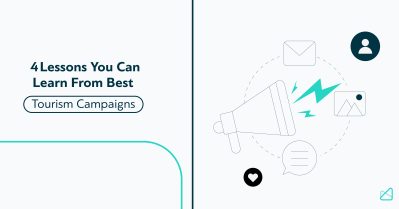Introduction to 2022 Travel Trends: What is Slow Travel, Where Did it Come From, & More

The behavior patterns of travelers and their expectations and needs are all subject to change. Add to it the economic, political, and other factors such as an unforeseen worldwide pandemic, and you have yourself quite a dynamic market. However, travel industry organizations must adjust to these changes and accommodate the current needs of travelers.
The best thing to do is to stay tuned to the latest travel trends. One of the noteworthy emerging trends is slow tourism. We are talking about a trend projected to grow at a 10% compound annual growth rate.
Let’s see what it is and how you can add slow travel experiences to your offer.
What is Slow Travel?
Slow Travel is becoming more popular with every passing month. The COVID19 pandemic helped bring this trend from the background and make it even more popular. The bucket lists are driven by “let’s visit as many places as possible” are no longer the norm. What is slow travel, then?
As the name itself suggests, it is traveling at a slower pace. Instead of visiting as many places as possible in a short timeframe, slow tourism is an approach that makes travel more educational and engaging.
At the same time, slow travel aims to provide deeper, meaningful, and memorable experiences. Another commonly used name is Experienced Based Travel, which implies traveling at your own pace.

If it’s not about traveling to many places, what’s it about then? Slow travel is all about two things. First, it refers to traveling to only a handful of locations, giving travelers enough time to experience how the locals live and breathe.
Secondly, it’s about maintaining sustainability for both the local environment and welcoming communities. One of the recent studies outlines the following attributes of slow tourism:
- A new concept of travel;
- Change in the use of time during the stay;
- Focus on local and cultural;
- Increased sustainable and natural environment concerns;
- Authenticity;
- Increased quality of the experience.
Where did this Slow Tourism trend come from?
Slow Tourism is deeply rooted in the Slow Food trend. Slow Food started as a trend in the 1980s but quickly became so popular that it became a nationwide movement. The man behind the Slow Food movement is Carlo Petrini.
It all started with protesting the decision to open a McDonald’s restaurant near the Spanish Steps in Rome. The name came naturally and presented itself as an antonym for Fast Food.
The group of activists and Carlo Petrini didn’t only want to resist the opening of the restaurant. Their main goal was to stand up for the slow pace of life, local foods and drinks as gastronomic experiences, and local traditions.
Now that you understand what Slow Travel is and where it comes from let’s see the profile of a “slower” traveler.
What does it really mean to be a “slower” traveler?
According to a Research study on Slow Tourism international trends and innovations, there are many attributes that define Slow Travel and Slow Travelers as such. A slower traveler chooses different transportation means than the regular one.
They are more interested in walking, running, cycling, and wandering during their stay. Slower travelers also prefer more ecologically responsible means of transportation to get to destinations, including sailing, canoeing, kayaking, coaches, buses, caravans, and auto-campers.
When it comes to leisure, slow travelers will often choose anything ranging from nature and bird watching to creativity and learning experiences. Instead of staying in big brand hotels, these travelers look for small family hotels and B&B. They also look for boutique hotels, rural accommodation, and eco-lodging.
They prefer to dine in small traditional, starred, and organic restaurants that use organic and local groceries, enabling them to taste the local cuisine. They want food that’s prepared with love and care.
A slower traveler also has a different attitude towards the travel experience. They are interested in disconnecting from their everyday lives and diving into the destination and all it has to offer.
Tools or websites available to build you a “slow trip”
Adding a “slow trip” offer to travelers is the best way to respond to this trend. There are a couple of tools and websites that you can use to build “slow trip” offers. Let’s start with the websites where you can seek inspiration.
Pinterest is a very popular platform. Bloggers and travelers constantly add new content. Plus, it has the “Pin” feature, which lets you explore related and most popular pins to slow travel. You can learn which destinations offer immersive experiences and add them to your offer.
YouTube
If you need more inspiration, YouTube is an excellent platform to complement your finds on Pinterest. You can use different keywords such as hidden gems, secret locations, country trips, and local dishes you must try. It can help you discover fantastic slow travel opportunities to build your itineraries around.
Structure your slow trip offer
Here is a great workbook that you can use to structure your slow trip offers. It can help you understand what it takes to create a slow experience and position your brand as one specializing in Slow Trips. You can also use it to develop products and analyze the current situation.
Conclusion
Slow Travel is one of those trends that can have the potential to significantly impact the travel industry. Hopefully, the information we’ve shared can help you adjust your offer to reflect modern travelers’ needs. With access to the right tools and websites, you can streamline this process and ensure your travel organization remains competitive in your market.
Subscribe to
our newsletter
Yay! You are now
subscribed to our
newsletter
Mize is the leading hotel booking optimization solution in the world. With over 170 partners using our fintech products, Mize creates new extra profit for the hotel booking industry using its fully automated proprietary technology and has generated hundreds of millions of dollars in revenue across its suite of products for its partners. Mize was founded in 2016 with its headquarters in Tel Aviv and offices worldwide.
Related Posts

Travel Niche: What It Is, How to Leverage It, Case Studies & More
14 min. Niche travel is one of the few travel sectors that have maintained their pre-COVID market growth. By catering to specific traveler segments, niche travel developed products around adventure travel, eco-tourism, LGBTQ+ travel, and wellness retreats. Take adventure tourism as only one segment of the niche tourism market. In 2021, it reached 288 billion […]

4 Lessons You Can Learn From the Best Tourism Campaigns
13 min. Businesses in the tourism industry rely heavily on marketing to generate leads and boost conversion rates. Tourism marketing is as old as tourism itself – and it always reflects the destination and service benefits relevant to the current travelers’ needs, wants, and expectations. In other words, tourism campaigns must constantly move forward, and […]

The Vital Role of Market Segmentation in the Tourism Industry
15 min. The tourism industry is an ever-growing and competitive landscape, presenting both challenges and opportunities for businesses operating within it. This is where market segmentation comes in handy. In this blog post, we will discuss what market segmentation is, the importance of market segmentation in the tourism industry, and how online travel agencies can […]
